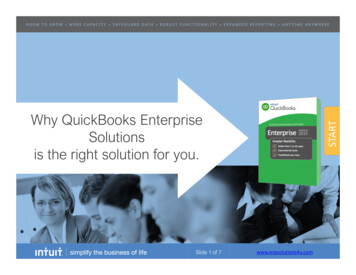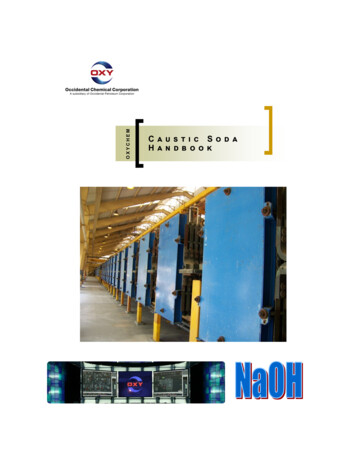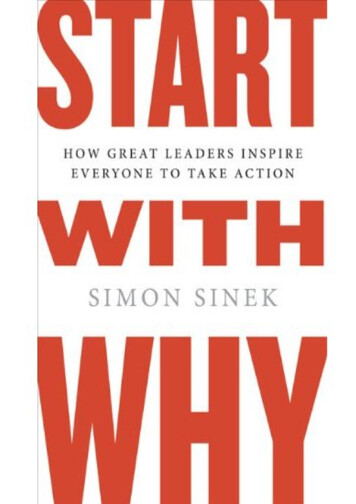
Transcription
START WITHWHYHOW GREAT LEADERS INSPIREEVERYONE TO TAKE ACTIONSIMON SINEKPORTFOLIO
PORTFOLIOPublished by the Penguin GroupPenguin Group (USA) Inc., 375 Hudson Street, New York, New York 10014, U.S.A. Penguin Group (Canada), 90Eglinton Avenue East, Suite 700, Toronto, Ontario, Canada M4P 2Y3 (a division of Pearson Penguin Canada Inc.)Penguin Books Ltd, 80 Strand, London WC2R ORL, EnglandPenguin Ireland, 25 St. Stephen's Green, Dublin 2, Ireland (a division of Penguin Books Ltd) Penguin BooksAustralia Ltd, 250 Camberwell Road, Camberwell, Victoria 3124, Australia (a division of Pearson AustraliaGroup Pty Ltd)Penguin Books India Pvt Ltd, 11 Community Centre, Panchsheel Park,New Delhi- 110017, IndiaPenguin Group (NZ), 67 Apollo Drive, Rosedale, North Shore 0632,New Zealand (a division of Pearson New Zealand Ltd)Penguin Books (South Africa) (Pty) Ltd, 24 Sturdee Avenue,Rosebank, Johannesburg 2196, South AfricaPenguin Books Ltd, Registered Offices: 80 Strand, London WC2R ORL, EnglandFirst published in 2009 by Portfolio, a member of Penguin Group (USA) Inc.7 9 10 8 6Copyright Simon Sinek, 2009 All rights reserved"The Sneetches" from The Sneetches and Other Stories by Dr. Seuss. Trademark TM and copyright by Dr. SeussEnterprises, L.P. 1953,1954,1961, renewed 1989. All rights reserved. Used by permission of Random HouseChildren's Books, a division of Random House, Inc. and International Creative Management, Inc., agents for Dr.Seuss Enterprises, L.P.LIBRARY OF CONGRESS C ATALO GIN G -1N - P UBLI C AT IO N DATA Sinek, Simon.Start with why: how great leaders inspire everyone to take action / by Simon Sinek. p. cm.Includes bibliographical references and index. ISBN 978-1-59184-280-4 1. Leadership. I. Tide. HD57.7.S549 2009658.4*092—dc22 2009021862Printed in the United States of America Set in MinionDesigned by Victoria HartmanWithout limiting the rights under copyright reserved above, no part of this publication may be reproduced,stored in or introduced into a retrieval system, or transmitted, in any form or by any means (electronic,mechanical, photocopying, recording or otherwise), without the prior written permission of both thecopyright owner and the above publisher of this book.The scanning, uploading, and distribution of this book via the Internet or via any other means without thepermission of the publisher is illegal and punishable by law. Please purchase only authorized electronic editionsand do not participate in or encourage electronic piracy of copyrightable materials. Your support of the author'srights is appreciated.While the author has made every effort to provide accurate telephone numbers and Internet addresses at thetime of publication, neither the publisher nor the author assumes any responsibility for errors, or for changesthat occur after publication. Further, publisher does not have any control over and does not assume anyresponsibility for author or third-party Web sites or their content.
For Victoria,who finds good ideasand makes them great
There are leaders and there are those who lead. Leadershold a position of power or influence. Those who leadinspire us.Whether individuals or organizations, we follow those who leadnot because we have to, but because we want to. We follow thosewho lead not for them, but for ourselves.This is a book for those who want to inspire others and for thosewho want to find someone to inspire them.
CONTENTSIntroduction: Why Start with Why?1PART 1:1: A WORLD THAT DOESN'T START WITH WHY1. Assume You Know2. Carrots and Sticks1117PART 2: AN ALTERNATIVE PERSPECTIVE3. The Golden Circle4. This Is Not Opinion, This Is Biology5. Clarity, Discipline and Consistency415771PART 3: LEADERS NEED A FOLLOWING6. The Emergence of Trust7. How a Tipping Point Tips91127PART 4: HOW TO RALLY THOSE WHO BELIEVE8. Start with WHY, but Know HOW9. Know WHY. Know HOW. Then WHAT?10. Communication Is Not About Speaking,It's About Listening147171179
PART 5: THE BIGGEST CHALLENGE IS SUCCESS11. When WHY Goes Fuzzy12. Split Happens195205PART 6: DISCOVER WHY13. The Origins of a WHY14. The New Competition233AcknowledgmentsNotes251257247
INTRODUCTIONWHY START WITH WHY?This book is about a naturally occurring pattern, a way of thinking,acting and communicating that gives some leaders the ability toinspire those around them. Although these "natural-born leaders"may have come into the world with a predisposition to inspire, theability is not reserved for them exclusively. We can all learn thispattern. With a little discipline, any leader or organization can inspire others, both inside and outside their organization, to helpadvance their ideas and their vision. We can all learn to lead.The goal of this book is not simply to try to fix the things thataren't working. Rather, I wrote this book as a guide to focus on andamplify the things that do work. I do not aim to upset the solutionsoffered by others. Most of the answers we get, when based on soundevidence, are perfectly valid. However, if we're starting with thewrong questions, if we don't understand the cause, then even theright answers will always steer us wrong . eventually. The truth,you see, is always revealed. eventually.The stories that follow are of those individuals and organizationsthat naturally embody this pattern. They are the ones that start withWhy.1
START WITH WHY1.The goal was ambitious. Public interest was high. Experts wereeager to contribute. Money was readily available.Armed with every ingredient for success, Samuel PierpontLangley set out in the early 1900s to be the first man to pilot anairplane. Highly regarded, he was a senior officer at the Smithsonian Institution, a mathematics professor who had also worked atHarvard. His friends included some of the most powerful men ingovernment and business, including Andrew Carnegie and Alexander Graham Bell. Langley was given a 50,000 grant from the WarDepartment to fund his project, a tremendous amount of money forthe time. He pulled together the best minds of the day, a veritabledream team of talent and know-how. Langley and his team used thefinest materials, and the press followed him everywhere. People allover the country were riveted to the story, waiting to read that hehad achieved his goal. With the team he had gathered and ampleresources, his success was guaranteed.Or was it?A few hundred miles away, Wilbur and Orville Wright wereworking on their own flying machine. Their passion to fly was sointense that it inspired the enthusiasm and commitment of a dedicated group in their hometown of Dayton, Ohio. There was nofunding for their venture. No government grants. No high-levelconnections. Not a single person on the team had an advanceddegree or even a college education, not even Wilbur or Orville. Butthe team banded together in a humble bicycle shop and made theirvision real. On December 17, 1903, a small group witnessed a mantake flight for the first time in history.How did the Wright brothers succeed where a better-equipped,better-funded and better-educated team could not?2
WHY STAR WITH WHYIt wasn't luck. Both the Wright brothers and Langley were highlymotivated. Both had a strong work ethic. Both had keen scientificminds. They were pursuing exactly the same goal, but only theWright brothers were able to inspire those around them and trulylead their team to develop a technology that would change theworld. Only the Wright brothers started with Why.2.In 1965, students on the campus of the University of California,Berkeley, were the first to publicly burn their draft cards to protestAmerica's involvement in the Vietnam War. Northern Californiawas a hotbed of antigovernment and antiestablishment sentiment;footage of clashes and riots in Berkeley and Oakland was beamedaround the globe, fueling sympathetic movements across the UnitedStates and Europe. But it wasn't until 1976, nearly three years afterthe end of America's military involvement in the Vietnam conflict,that a different revolution ignited.They aimed to make an impact, a very big impact, even challenge the way people perceived how the world worked. But theseyoung revolutionaries did not throw stones or take up arms againstan authoritarian regime. Instead, they decided to beat the system atits own game. For Steve Wozniak and Steve Jobs, the cofounders ofApple Computer, the battlefield was business and the weapon ofchoice was the personal computer.The personal computer revolution was beginning to brew whenWozniak built the Apple I. Just starting to gain attention, the technology was primarily seen as a tool for business. Computers weretoo complicated and out of the price range of the average individual. But Wozniak, a man not motivated by money, envisioned anobler purpose for the technology. He saw the personal computeras a way for the little man to take on a corporation. If he could3
START WITH WHYfigure out a way to get it in the hands of the individual, he thought,the computer would give nearly anyone the ability to perform manyof the same functions as a vastly better resourced company. Thepersonal computer could level the playing field and change the waythe world operated. Woz designed the Apple I, and improved thetechnology with the Apple II, to be affordable and simple to use.No matter how visionary or how brilliant, a great idea or a greatproduct isn't worth much if no one buys it. Wozniak's best friend atthe time, the twenty-one-year-old Steve Jobs, knew exactly what todo. Though he had experience selling surplus electronics parts, Jobswould prove to be much more than a good salesman. He wanted todo something significant in the world, and building a company washow he was going to do it. Apple was the tool he used to ignite hisrevolution.In their first year in business, with only one product, Applemade a million dollars in revenues. By year two, they did 10 million in sales. In their fourth year they sold 100 million worth ofcomputers. And in just six years, Apple Computer was a billiondollar company with over 3,000 employees.Jobs and Woz were not the only people taking part in the personal computer revolution. They weren't the only smart guys in thebusiness; in fact, they didn't know much about business at all. Whatmade Apple special was not their ability to build such a fast-growthcompany. It wasn't their ability to think differently about personalcomputers. What has made Apple special is that they've been able torepeat the pattern over and over and over. Unlike any of theircompetitors, Apple has successfully challenged conventional thinking within the computer industry, the small electronics industry, themusic industry, the mobile phone industry and the broaderentertainment industry. And the reason is simple. Apple inspires.Apple starts with Why.4
WHY STAR WITH WHY3.He was not perfect. He had his complexities. He was not the onlyone who suffered in a pre-civil rights America, and there wereplenty of other charismatic speakers. But Martin Luther King Jr. hada gift. He knew how to inspire people.Dr. King knew that if the civil rights movement was to succeed,if there was to be a real, lasting change, it would take more than himand his closest allies. It would take more than rousing words andeloquent speeches. It would take people, tens of thousands ofaverage citizens, united by a single vision, to change the country. At11:00 a.m. on August 28, 1963, they would send a message to Washington that it was time for America to steer a new course.The organizers of the civil rights movement did not send outthousands of invitations, nor was there a Web site to check the date.But the people came. And they kept coming and coming. All told, aquarter of a million people descended on the nation's capital in timeto hear the words immortalized by history, delivered by the manwho would lead a movement that would change America forever: "Ihave a dream."The ability to attract so many people from across the country, ofall colors and races, to join together on the right day, at the righttime, took something special. Though others knew what had tochange in America to bring about civil rights for all, it was MartinLuther King who was able to inspire a country to change not just forthe good of a minority, but for the good of everyone. MartinLuther King started with Why. . .There are leaders and there are those who lead. With only 6 percentmarket share in the United States and about 3 percent worldwide,Apple is not a leading manufacturer of home computers. Yet thecompany leads the computer industry and is now a leader in other5
START WITH WHYindustries as well. Martin Luther King's experiences were notunique, yet he inspired a nation to change. The Wright brotherswere not the strongest contenders in the race to take the firstmanned, powered flight, but they led us into a new era of aviationand, in doing so, completely changed the world we live in.Their goals were not different than anyone else's, and their systems and processes were easily replicated. Yet the Wright brothers,Apple and Martin Luther King stand out among their peers. Theystand apart from the norm and their impact is not easily copied.They are members of a very select group of leaders who do something very, very special. They inspire us.Just about every person or organization needs to motivate othersto act for some reason or another. Some want to motivate a purchasedecision. Others are looking for support or a vote. Still others arekeen to motivate the people around them to work harder or smarteror just follow the rules. The ability to motivate people is not, initself, difficult. It is usually tied to some external factor. Temptingincentives or the threat of punishment will often elicit the behaviorwe desire. General Motors, for example, so successfully motivatedpeople to buy their products that they sold more cars than any otherautomaker in the world for over seventy- seven years. Though theywere leaders in their industry, they did not lead.Great leaders, in contrast, are able to inspire people to act. Thosewho are able to inspire give people a sense of purpose or belongingthat has little to do with any external incentive or benefit to begained. Those who truly lead are able to create a following of peoplewho act not because they were swayed, but because they wereinspired. For those who are inspired, the motivation to act is deeplypersonal. They are less likely to be swayed by incentives. Those whoare inspired are willing to pay a premium or endure inconvenience,even personal suffering. Those who are able to inspire will create afollowing of people—supporters, voters, customers, workers—who6
WHY STAR WITH WHYact for the good of the whole not because they have to, but becausethey want to.Though relatively few in number, the organizations and leaderswith the natural ability to inspire us come in all shapes and sizes.They can be found in both the public and private sectors. They arein all sorts of industries—selling to consumers or to other businesses. Regardless of where they exist, they all have a disproportionate amount of influence in their industries. They have the mostloyal customers and the most loyal employees. They tend to be moreprofitable than others in their industry. They are more innovative,and most importantly, they are able to sustain all these things overthe long term. Many of them change industries. Some of them evenchange the world.The Wright brothers, Apple and Dr. King are just three exampies. Harley-Davidson, Disney and Southwest Airlines are threemore. John F. Kennedy and Ronald Reagan were also able to inspire.No matter from where they hail, they all have something incommon. All the inspiring leaders and companies, regardless of sizeor industry, think, act and communicate exactly alike.And it's the complete opposite of everyone else.What if we could all learn to think, act and communicate likethose who inspire? I imagine a world in which the ability to inspireis practiced not just by a chosen few, but by the majority. Studiesshow that over 80 percent of Americans do not have their dream job.If more knew how to build organizations that inspire, we could livein a world in which that statistic was the reverse—a world in whichover 80 percent of people loved their jobs. People who love going towork are more productive and more creative. They go homehappier and have happier families. They treat their colleagues andclients and customers better. Inspired employees make for strongercompanies and stronger economies. That is why I wrote this book. Ihope to inspire others to do the things that inspire them so that7
START WITH WHYtogether we may build the companies, the economy and a world inwhich trust and loyalty are the norm and not the exception. Thisbook is not designed to tell you what to do or how to do it. Its goalis not to give you a course of action. Its goal is to offer you the causeof action.For those who have an open mind for new ideas, who seek tocreate long-lasting success and who believe that your success requires the aid of others, I offer you a challenge. From now on, startwith Why.8
ASSUME YOU KNOWPART IA WORLD THATDOESN'T STARTWITH WHY9
START WITH WHY10
1ASSUME YOU KNOWOn a cold January day, a forty-three-year-old man wassworn in as the chief executive of his country. By his sidestood his predecessor, a famous general who, fifteen yearsearlier, had commanded his nation's armed forces in a warthat resulted in the defeat of Germany. The young leaderwas raised in the Roman Catholic faith. He spent the nextfive hours watching parades in his honor and stayed upcelebrating until three o'clock in the morning.You know who I'm describing, right?It's January 30, 1933, and I'm describing Adolf Hitler and not, asmost people would assume, John F. Kennedy.The point is, we make assumptions. We make assumptions aboutthe world around us based on sometimes incomplete or falseinformation. In this case, the information I offered was incomplete.Many of you were convinced that I was describing John F. Kennedyuntil I added one minor little detail: the date.This is important because our behavior is affected by our assumptions or our perceived truths. We make decisions based onwhat we think we know. It wasn't too long ago that the majority of11
START WITH WHYpeople believed the world was flat. This perceived truth impactedbehavior. During this period, there was very little exploration. People feared that if they traveled too far they might fall off the edge ofthe earth. So for the most part they stayed put. It wasn't until thatminor detail was revealed—the world is round—that behaviorschanged on a massive scale. Upon this discovery, societies began totraverse the planet. Trade routes were established; spices weretraded. New ideas, like mathematics, were shared between societieswhich unleashed all kinds of innovations and advancements. Thecorrection of a simple false assumption moved the human raceforward.Now consider how organizations are formed and how decisionsare made. Do we really know why some organizations succeed andwhy others don't, or do we just assume? No matter your definitionof success—hitting a target stock price, making a certain amount ofmoney, meeting a revenue or profit goal, getting a big promotion,starting your own company, feeding the poor, winning publicoffice—how we go about achieving our goals is very similar. Someof us just wing it, but most of us try to at least gather some data sowe can make educated decisions. Sometimes this gathering processis formal—like conducting polls or market research. And sometimesit's informal, like asking our friends and colleagues for advice orlooking back on our own personal experience to provide someperspective. Regardless of the process or the goals, we all want tomake educated decisions. More importantly, we all want to makethe right decisions.As we all know, however, not all decisions work out to be theright ones, regardless of the amount of data we collect. Sometimesthe impact of those wrong decisions is minor, and sometimes it canbe catastrophic. Whatever the result, we make decisions based on aperception of the world that may not, in fact, be completely accurate. Just as so many were certain that I was describing John F.12
ASSUME YOU KNOWKennedy at the beginning of this section. You were certain you wereright. You might even have bet money on it—a behavior based onan assumption. Certain, that is, until I offered that little detail of thedate.Not only bad decisions are made on false assumptions. Sometimes when things go right, we think we know why, but do we really? That the result went the way you wanted does not mean youcan repeat it over and over. I have a friend who invests some of hisown money. Whenever he does well, it's because of his brains andability to pick the right stocks, at least according to him. But whenhe loses money, he always blames the market. I have no issue witheither line of logic, but either his success and failure hinge upon hisown prescience and blindness or they hinge upon good and badluck. But it can't be both.So how can we ensure that all our decisions will yield the bestresults for reasons that are fully within our control? Logic dictatesthat more information and data are key. And that's exactly what wedo. We read books, attend conferences, listen to podcasts and askfriends and colleagues—all with the purpose of finding out more sowe can figure out what to do or how to act. The problem is, we've allbeen in situations in which we have all the data and get lots of goodadvice but things still don't go quite right. Or maybe the impactlasted for only a short time, or something happened that we couldnot foresee. A quick note to all of you who correctly guessed AdolfHitler at the beginning of the section: the details I gave are the samefor both Hitler and John F. Kennedy, it could have been either. Youhave to be careful what you think you know. Asumptions, you see,even when based on sound research, can lead us astray.Intuitively we understand this. We understand that even withmountains of data and good advice, if things don't go as expected,it's probably because we missed one, sometimes small but vital detail. In these cases, we go back to all our sources, maybe seek out13
START WITH WHYsome new ones, and try to figure out what to do, and the wholeprocess begins again. More data, however, doesn't always help, especially if a flawed assumption set the whole process in motion inthe first place. There are other factors that must be considered, factors that exist outside of our rational, analytical, informationhungry brains.There are times in which we had no data or we chose to ignorethe advice or information at hand and just went with our gut andthings worked out just fine, sometimes even better than expected.This dance between gut and rational decision-making pretty muchcovers how we conduct business and even live our lives. We cancontinue to slice and dice all the options in every direction, but atthe end of all the good advice and all the compelling evidence,we're left where we started: how to explain or decide a course ofaction that yields a desired effect that is repeatable. How can wehave 20/20 foresight?There is a wonderful story of a group of American car executiveswho went to Japan to see a Japanese assembly line. At the end of theline, the doors were put on the hinges, the same as in America. Butsomething was missing. In the United States, a line worker wouldtake a rubber mallet and tap the edges of the door to ensure that itfit perfectly. In Japan, that job didn't seem to exist. Confused, theAmerican auto executives asked at what point they made sure thedoor fit perfectly. Their Japanese guide looked at them and smiledsheepishly. "We make sure it fits when we design it." In theJapanese auto plant, they didn't examine the problem andaccumulate data to figure out the best solution—they engineeredthe outcome they wanted from the beginning. If they didn't achievetheir desired outcome, they understood it was because of a decisionthey made at the start of the process.At the end of the day, the doors on the American-made andJapanese-made cars appeared to fit when each rolled off the as-14
ASSUME YOU KNOWsembly line. Except the Japanese didn't need to employ someone tohammer doors, nor did they need to buy any mallets. More importantly, the Japanese doors are likely to last longer and maybe evenbe more structurally sound in an accident. All this for no otherreason than they ensured the pieces fit from the start.What the American automakers did with their rubber mallets isa metaphor for how so many people and organizations lead. Whenfaced with a result that doesn't go according to plan, a series ofperfectly effective short-term tactics are used until the desired outcome is achieved. But how structurally sound are those solutions?So many organizations function in a world of tangible goals and themallets to achieve them. The ones that achieve more, the ones thatget more out of fewer people and fewer resources, the ones with anoutsized amount of influence, however, build products and companies and even recruit people that all fit based on the originalintention. Even though the outcome may look the same, great leaders understand the value in the things we cannot see.Every instruction we give, every course of action we set, everyresult we desire, starts with the same thing: a decision. There arethose who decide to manipulate the door to fit to achieve the desiredresult and there are those who start from somewhere very different.Though both courses of action may yield similar short- term results,it is what we can't see that makes long-term success morepredictable for only one. The one that understood why the doorsneed to fit by design and not by default.15
16
2CARROTS AND STICKSManipulation vs. InspirationThere's barely a product or service on the market today that customers can't buy from someone else for about the same price, aboutthe same quality, about the same level of service and about the samefeatures. If you truly have a first-mover's advantage, it's probablylost in a matter of months. If you offer something truly novel,someone else will soon come up with something similar and maybeeven better.But if you ask most businesses why their customers are theircustomers, most will tell you it's because of superior quality, features, price or service. In other words, most companies have no cluewhy their customers are their customers. This is a fascinatingrealization. If companies don't know why their customers are theircustomers, odds are good that they don't know why their employeesare their employees either.If most companies don't really know why their customers aretheir customers or why their employees are their employees, then17
START WITH WHYhow do they know how to attract more employees and encourageloyalty among those they already have? The reality is, most businesses today are making decisions based on a set of incomplete or,worse, completely flawed assumptions about what's driving theirbusiness.There are only two ways to influence human behavior: you canmanipulate it or you can inspire it. When I mention manipulation,this is not necessarily pejorative; it's a very common and fairly benign tactic. In fact, many of us have been doing it since we wereyoung. "I'll be your best friend" is the highly effective negotiatingtactic employed by generations of children to obtain something theywant from a peer. And as any child who has ever handed overcandy hoping for a new best friend will tell you, it works.From business to politics, manipulations run rampant in allforms of sales and marketing. Typical manipulations include: dropping the price; running a promotion; using fear, peer pressure oraspirational messages; and promising innovation to influencebehavior—be it a purchase, a vote or support. When companies ororganizations do not have a clear sense of why their customers aretheir customers, they tend to rely on a disproportionate number ofmanipulations to get what they need. And for good reason. Manipulations work.PriceMany companies are reluctant to play the price game, but they doso because they know it is effective. So effective, in fact, that thetemptation can sometimes be overwhelming. There are few professional services firms that, when faced with an opportunity to land abig piece of business, haven't just dropped their price to make thedeal happen. No matter how they rationalized it to themselves ortheir clients, price is a highly effective manipulation. Drop yourprices low enough and people will buy from you. We see it at the18
CARROTS AND STICKSend of a retail season when products are "priced to move." Drop theprice low enough and the shelves will very quickly clear to makeroom for the next season's products.Playing the price game, however, can come at tremendous costand can create a significant dilemma for the company. For the seller,selling based on price is like heroin. The short-term gain is fantastic,but the more you do it, the harder it becomes to kick the habit. Oncebuyers get used to paying a lower-than-average price for a productor service, it is very hard to get them to pay more. And the sellers,facing overwhelming pressure to push prices lower and lower inorder to compete, find their margins cut slimmer and slimmer. Thisonly drives a need to sell more to compensate. And the quickestway to do that is price again. And so the downward spiral of priceaddiction sets in. In the drug world, these addicts are called junkies.In the business world, we call them commodities. Insurance. Homecomputers. Mobile phone service. Any number of packaged goods.The list of commodities created by the price game goes on and on.In nearly every circumstance, the companies that are forced to treattheir products as commodities brought it upon themselves. I cannotdebate that dropping the price
LIBRARY OF CONGRESS C ATALO GIN G -1N - P UBLI C AT IO N DATA Sinek, Simon. Start with why: how great leaders inspire everyone to take action / by Simon Sinek. p. cm. Includes bibliographical references and index. ISBN 978-1-59184-280-4 1. Leadership. I. Tide. HD57.7.S549 2009 658.4*092—dc22 2009021862
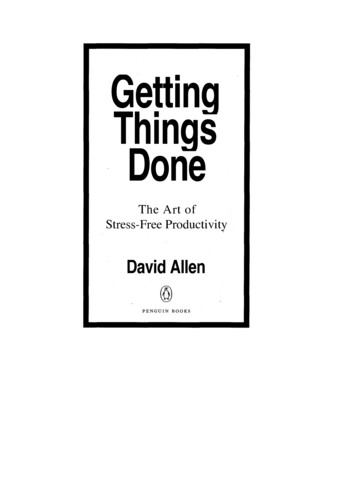
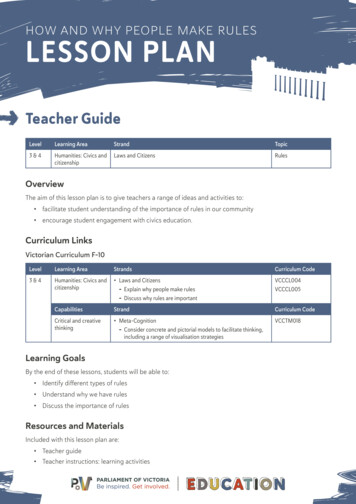



![[Page 1 – front cover] [Show cover CLEAN GET- AWAY 978-1 .](/img/13/9781984892973-6648.jpg)


